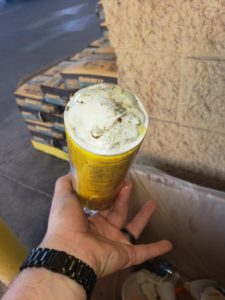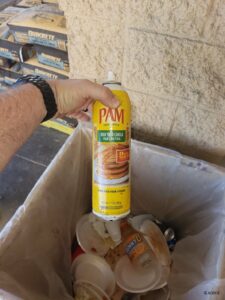A Texas woman preparing peach cobbler sustained severe burns when a can of Pam cooking spray she had used to coat a baking dish exploded. The woman had placed the spray can on a wooden cart near her stove when she placed the cobbler in the oven. Suddenly, she heard a loud noise and observed the highly combustible contents of the cooking spray shooting through U-shaped vents in the bottom of the can.
The contents “exploded into flames,” causing severe injury to the woman, who suffered second and third-degree burns over 27 percent of her upper body as well as blindness in one of her eyes. She spent a week in a medically induced coma and, in the two years since the accident happened, has been forced to change careers due to the disfiguring scars that the accident left on her body.


The woman’s lawsuit against Conagra—the maker of Pam Cooking Spray—was one of six filed in May of this year. As of late September 2019, a total of 33 lawsuits had been filed against the company, all of them alleging that the U-shaped vent system at the bottom of the can made it prone to exploding. Most of the claimants in the lawsuits suffered serious burns and many required skin grafts.
The suits also state that Conagra failed to warn consumers adequately of the explosion risks on the warning label placed on the cooking spray. The lawsuits were all filed in Cook County, Illinois, as Conagra is based in Chicago. Also named in the lawsuits is DS Containers, a Japan-based business that designed the cans for the spray. Attorneys representing injured individuals in the lawsuits acknowledged that there are likely many more people who have been injured by the cooking spray cans but did not realize that the can’s design was the reason for the explosion or the kitchen fire.
If you’ve been injured by Pam cooking spray or another faulty product, a product liability attorney with experience in product liability can help you understand your legal options.
What Caused the Cans to Explode?
According to information gleaned from the filed lawsuits, the four U-shaped vents in the can are designed to relieve pressure when the can is overheated. However, the vents caused flammable liquid, containing ingredients such as butane and propane, to seep out even when the cans were properly stored and used as recommended on the product’s label. The product’s label states that Pam cooking spray should not be stored near a heat source or exposed to temperatures of more than 120 degrees.
The U-shaped vent system was reportedly used on a limited number of larger (10 oz. or higher) cans of the product, primarily those designed for restaurant use, and appeared under different store-brand labels as well as the Pam label. The store brands that are also manufactured by Conagra and named in some of the lawsuits include Sysco, Wellsley Farms, and Members Mark.
The Manufacturer’s Response
Video of Pam cooking spray exploding.
A company spokesman stated in May 2019 that the cooking sprays had been safely used by consumers for 50 years. However, Conagra removed the vented cans from production earlier in the year, stating that it was seeking to standardize the cans that contain all of the varieties of cooking sprays that it has available for consumers. The company maintains that the product is completely safe if used according to the label. A number of the U-vent cans may remain on store shelves and at online stores such as Amazon, and plaintiffs are seeking to recall those cans.
“All Pam Cooking Sprays include large, clear instructions, warnings and cautions on both the front and the back of the packaging,” the company spokesman stated, noting that the labels are there to remind consumers to use the product safely and not leave the can near a stove or other heat source. However, when pressed as to how close “near” a heat source is, the spokesman said that safe storage depended on the heat source, room ventilation, and room size.
What Is Product Liability?
Those who create products for public use or consumption have both a moral and a legal responsibility to ensure that their products are safe. When a manufacturer designs, manufactures, or markets a product that—even when used according to the label—injures a consumer, that manufacturer may be subject to a product liability lawsuit. In addition to Pam cooking spray and other products designed for use while cooking, product liability laws cover dangerous defects to products such as:
- Cars and other vehicles, as well as their mechanical parts
- Children’s toys
- Electronic devices
- Household appliances
- Medical equipment
- Prescription and over-the-counter medication
- Food, both packaged and fresh
3 Types of Product Liability Claims

With the help of a skilled personal injury attorney guiding you through the injury accident claim process, victims can make three types of product liability claims against the manufacturers of defective or malfunctioning products:
- Design defect: If a product is defective due to its design and that design defect resulted in injury to the consumer, he or she may be permitted to seek compensation through a product liability lawsuit citing defective design.
- Manufacturing defect: If the product was designed safely, yet failed to operate safely due to a problem with the manufacturing process, then manufacturing defect would be cited as the reason for the claim.
- Inadequate notification of hazards: Manufacturers are required to list known hazards on the warning label. If they fail to do so or if the notification doesn’t adequately describe what can cause a hazard to occur, then inadequate notification of hazards will be the reason for the product liability lawsuit.
Some product liability claims feature more than one type of claim. For example, the claimants in the Pam cooking spray lawsuits have not only stated that the design of the U-shape vent in the cans was defective, but that the risk of combustion was inadequately described because it did not list exactly how near to heat sources the can could safely sit.
If you were injured by Pam cooking spray or another defective product, a personal injury lawyer can help you recover compensation for your injuries.

